History
1949-1972
The Regiment of the Sri Lanka Army Ordnance became a Corps on 14 October 1949. With the raising of Ceylon Army in 1949, munitions of the Royal Ordnance were accepted and stacked in government storerooms. The Ordnance storeroom was established on 1 February 1950 in Kirulapone.
Major B G Brecher was the first Director of the Sri Lanka Ordnance. He was dispatched to Sri Lanka on 11 March 1950. The initial plan was laid down by him with the advice of Wolly Rowi. Sri Lanka Corps of Ordnance was officially established as a Unit on 29 March 1950 with 2 Commissioned Officers, 2 Warrant Officers, 1 Staff Sergeant, and 3 Sergeants under the direction of Major B G Brecher. Its founder members were Captain ED Ebert, Lieutenant AADB Perera, WO I, BC Waisse, WO I, PM Rathnayake, Staff Sergeant Wickramaseka WEB, Sergeant Karunathilaka MLWB, Sergeant Ebert JAVD, Sergeant De Alwis CS.
Cylon Ordnance Corps was the youngest Commonwealth member to have been raised according to Royal Ordnance. Other ranks were first recruited to the Corps on 7 February 1950. During the initial years, the Corps operated as two units - the Directorate of Ordnance Services was at the Army Headquarters while the Ordnance Depot was located in Kirulapone.
Policy affairs, planning and inventorying were the responsibility of the Ordnance Directorate, while acceptance of goods, stocking, and issuance were the responsibilities of the issuing depot. The first-ever stock was what the Army purchased from the Royal Ordnance.
An Arms and Ammunition unit was established at Army Headquarters on 23 March 1950. Its first staff included one officer and three other ranks. As the responsibilities assigned to them were growing, the first ordnance depot was established as part Sri Lanka Electrical Mechanical Engineering Corp. This unit functioned according to the Royal Ordnance Depot which was part of Royal Electrical and Mechanical Engineering Corps.
The Kirulapone Ordnance Depot was shifted to Panagoda Army Cantonment, Panagoda in July 1955 where it remained. In March 1956, the Sri Lanka Corps of Ordnance was separated from the Royal Army Ordnance Crops. The officers, therefore, returned to their country, and in the same month, Lt Col DFT Abeysinghe was appointed the unit's first Commanding Officer . At the time, the Corps consisted of 6 officers and 176 other ranks.
Thereafter, the SLAOC was functioning jointly with the Ordnance Director under the supervision of senior Stock control officer and accounts officer. All duties pertaining to SLAOC were performed under the SLAOC Directorate and the Commanding Officer SLAOC was answerable to the Army Commander on all technical affairs related to ordnance services.

The Royal Lincolnshire Regiment was a line infantry regiment of the British Army raised on 20 June 1685 as the Earl of Bath's Regiment for its first Colonel, John Granville, 1st Earl of Bath. In 1751, it was numbered like most other Army regiments and named the 10th Regiment of Foot. After the Childers Reforms of 1881, it became the Lincolnshire Regiment after the county where it had been recruiting since 1781.
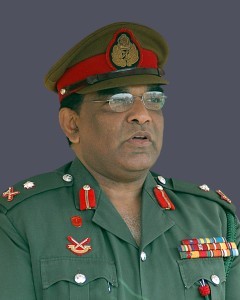
Lieutenant General Parami Sugandika Bandara Kulatunga, RSP, VSV, USP was a senior Sri Lanka Army officer. He was serving as the Deputy Chief of Staff of the Sri Lanka Army and its third highest-ranking officer at the time of his assassination. On the morning of 26 June, he was killed by a Tamil Tiger suicide bomber who drove an explosives laden motorbike into his staff car as it was driving to a military base at Pannipitiya near Colombo.

The Sri Lankan Army (SLA) is the oldest and largest of the Sri Lanka Armed Forces. Established as the Ceylon Army in 1949, it was renamed when Sri Lanka became a republic in 1972. In 2010, the Army had approximately 200,000 regular personnel, between 20,000 and 40,000 reserve (volunteer) personnel and 18,000 National Guardsmen and comprises 13 operational divisions, one air-mobile brigade, one commando brigade, one special forces brigade, one independent armored brigade, three mechanized infantry brigades and over 40 infantry brigades. From the 1980s to 2009 the army was engaged in the Sri Lankan Civil War.
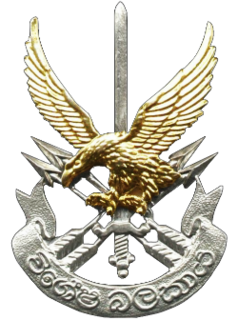
The Sri Lanka Army Special Forces Regiment (SF) is one of two special operations units of the Sri Lanka Army, alongside the Sri Lanka Army Commando Regiment. Since its inception as a combat tracker team in 1986, the unit gradually expanded into a brigade consisting of four regiments. It is one of the top-secret units in the Sri Lanka Army. The Special Forces basic training is said to be the toughest of its kind in Sri Lanka.

The Sri Lanka Artillery (SLA) is the artillery arm of the Sri Lanka Army. It is made up of ten regular regiments and two volunteer regiments. The SLA is headquartered at Panagoda Cantonment, Panagoda.
The Sri Lanka Engineers (SLE) is a combat support arm of the Sri Lanka Army which provides military engineering. It is made up of ten regular regiments and one volunteer regiment. Headquartered at Army Cantonment, Panagoda, it is headed by the Centre Commandant.
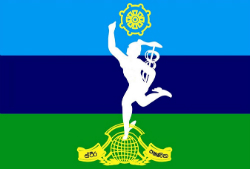
The Sri Lanka Signals Corps (SLSC) is a combat support corps of the Sri Lanka Army, responsible for providing military communications, information technology and electronic warfare support. The corps is made up of a signals brigade, ten regular regiments and one volunteer regiment. It is responsible for installing, maintaining and operating all types of telecommunications equipment and information systems. It is headquartered at the Panagoda Cantonment.
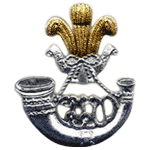
The Sri Lanka Light Infantry (SLLI) is the oldest regiment in the Sri Lanka Army and the oldest infantry regiment in the army. It is made up of ten regular battalions and five volunteer battalions, and is headquartered at the Panagoda Cantonment, Panagoda. Over the years it has become the most distinguished and dependable regiment in the army.

The Sri Lanka Sinha Regiment (SLSR) is an infantry regiment of the Sri Lanka Army; it is the second oldest infantry regiment in the army. It is made up of seven regular battalions, five volunteer battalions and a headquarters battalion at the Ambepussa Camp.
The National Cadet Corps (NCC) is a youth organisation in Sri Lanka, sponsored by the Ministry of Defence, which operates in schools, and normally includes Army, Navy and Air Force sections. The corp is open for secondary school students on voluntary basis and its officers are government teachers and educational administrators, who serve as instructors. The Cadets are given basic military training in small arms and parades, as well as leadership training.
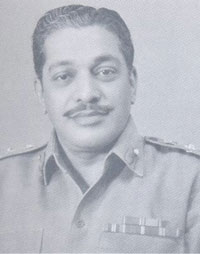
General Deshamanya Don Sepala Attygalle, LVO was a Sri Lankan military leader, civil servant and diplomat. The longest serving Commander of the Sri Lankan Army (1967–1977), he went on to serve as the Permanent secretary to the Ministry of Defence and Sri Lankan High Commissioner to the United Kingdom.
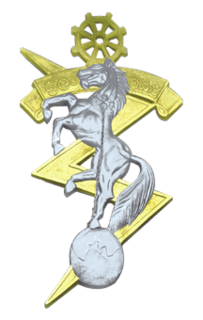
The Sri Lanka Electrical and Mechanical Engineers (SLEME) is a Combat Support corps of the Sri Lanka Army. It is made up of six regular regiments and one volunteer (reserve) regiment. Regiment Center located at Kew Road, Slave Island, Colombo. The present strength of the corps is 200 officers and 5763 other ranks.

The Sri Lanka Army Medical Corps (SLMC) is a specialist corps in the Sri Lanka Army which specializes in military medicine and provides medical services to all army personnel and their families in war and in peace. It is made up of 4 regular units and one volunteer unit. Headquartered in Colombo, formally at army headquarters. The corps Cap badge depicting the Rod of Asclepius. General officers and senior officers of the SLMC wear gorget patches of maroon rather than of scarlet worn by other officers of similar rank.

The Sri Lanka Army General Service Corps (SLAGSC) a corps of the Sri Lanka Army. The corps carries out much of the administrative work of the army. The role of the Corps is to provide logistic backing to Regular and Volunteer units by performing Financial/ Accounting Services, pay duties, legal services, running of agriculture projects and farms etc. Therefore, it is made up of Accountants, Legal Officers, Agriculture Offices, data processing officers and other ranks specialized in those fields. It is made up of a 3 regular units and 3 volunteer (reserve) units and is headquartered at its Regiment Center at the Panagoda Cantonment, Panagoda.

The Corps of Engineer Services (CES) a regiment of the Sri Lanka Army. The role of the Corps of Engineer Services is to design, construct and maintain all buildings, roads and associated facilities such as electricity, water supply and drainage systems used by the Sri Lanka Army, Apart from this, the Regiment is also responsible for the installation, maintenance and repair of all types of generators, water pumps, sewer pumps, desalination plants and other electrical appliances. It is made up of 6 regular units and 9 volunteer (reserve) units and is headquartered at its Regiment Center at the Panagoda Cantonment, Panagoda.
The 1918 New Year Honours were appointments by King George V to various orders and honours to reward and highlight good works by citizens of the British Empire. The appointments were published in The London Gazette and The Times in January, February and March 1918.
This is a list of Member of the Order of the British Empire (MBE) awards in the 1919 Birthday Honours.

On 21 July 1944, United States Marine and Army forces landed on the west coast of the island of Guam, the southernmost of the Mariana Islands. The island, a U.S. territory prior to World War II, had been captured by forces of the Empire of Japan 8–10 December 1941.
Major General Duleep Justin De Sliva Wickramanayake was a Sri Lankan military leader, he served as the Director Operations and Training of the Sri Lanka Army.
The Battle of Hong Kong was one of the first battles of the Pacific War in World War II.














